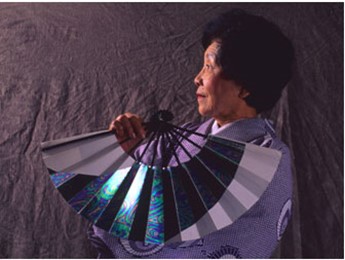Kazuko Law
1996 Florida Folk Heritage Award

Kazuko Law (b. 1929) excels in an amazing array of Japanese traditional arts: temari balls, tea ceremony, origami, Japanese dollmaking, as well as folk, semi-classical and classical dance. Born in Hokkaido, Law lived in China until she was 15. During the long cold winters her mother taught the children origami to entertain themselves or make presents. Since Law was a tomboy, her family also insisted on tea ceremony lessons to encourage more refined behavior. She began learning traditional Japanese dance at the age of five and studied the art form regularly until she was twenty-one.
Law first learned temari from her great grandmother in Japan, and made temari regularly until she finished high school. "Every evening after dinner we spent about 45 minutes with our grandparents," she recalls. "My grandmother would teach us and tell stories." In Japan, young people give temari to friends as special gifts and, as she says, “they take care of everything very nicely because what we do, we put our soul into what we make.” Whenever Law visits her family in Japan, she buys temari supplies and also learns new designs while by visiting older people who practice the art. Some of the “new” designs are, in fact, quite old.
Law is skilled at three styles of dance: classical, semi-classical, and folk. The classical and semi-classical forms began in the royal court and gradually became traditional dances. The folk dances were originated by peasant farmers. Every dance in the centuries-old Japanese tradition tells a story. The skilled dancer communicates through the use of symbolic hand and eye movements, costuming, fans, and flowers, as well as whole body movements and footwork. Fans are used to convey a number of ideas. In the hands of a skilled dancer, a fan may become a wine bottle, a walking stick, fishing pole, or a sword. Both men and women perform traditional Japanese dances, and tradition requires all dancers to learn the roles and steps of both genders. One of the most difficult things for a dancer to accomplish is maintaining proper eye expression, even when performing complex dance movements. “Eyes tell you a story,” says Law.
In recent decades, Law has frequently returned to Japan to continue studies in dance and the tea ceremony with respected master artists in Kyoto. In the Pensacola area, she continues to lead a dance group, teach Japanese arts, and demonstrate at many north Florida events. Law has been a master artist in the Folklife Apprenticeship Program for both temari and dance. She has also passed along knowledge of many of traditional Japanese arts to her daughter, Chieri Espasito. She received the Florida Folk Heritage Award in 1996.

